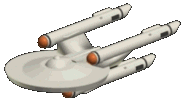Destroyers are a broad category of varying sized warships, used primarily as attack and patrol vessels along hostile boarders. Destroyers are specifically designed to engage enemy vessels of any configuration and maintain fire to disable or destroy an enemy force. Most destroyers are used in conjunction with other vessels and are capable of engaging other destroyers and capital ships. Destroyers have a number of specialized onboard combat systems, including Command and Control systems, Combat Information Centres, specialized deep space sensors and crew support systems. Destroyers also function as fast response vessels in and near established space lanes, responding to pirate attacks and providing heavy support for Merchant Marine Patrols near member planets.
None the less, Destroyers present a unique drawback to Federation planners. While all destroyers have moderately sized science research capabilities, most of these facilities are significantly smaller than on other Starship. Destroyer’s redundancy systems often take up large amounts of internal space, contributing to small crew quarters and lighter recreational facilities. To keep Destroyers stealthy, many have excellent passive sensor equipment, allowing them to detect even minute Tachyon particle movement from cloaked vessels.
Unfortunately, this specialized sensor ability also means that more powerful, active scanning systems are not installed, giving Destroyers a significant disadvantage in exploration situations. Destroyers do not usually mount troops, although several designs do have boarding parties for Maritime Patrol inspections. Destroyers also have smaller shuttle bays and smaller cargo bays. Most Destroyers are home ported at a front line star base or outpost, allowing them to refurbish their stores often.
Destroyers remain a mainstay of Federation and Klingon defence, due mostly to their inexpensiveness and combat ability. Two destroyers can often be built for the same resource cost as a single cruisers. Destroyers are also designed to be easily repaired and upgraded, with changes to their design often being made in the field.
The Heavy Destroyer is designed to provide significantly more firepower for destroyer units, often have equivalent combat capabilities to that of a Cruiser or Dreadnought. More manoeuvrable than Dreadnoughts and roomier than Heavy Cruisers, Heavy Destroyers are used primarily as focal points for destroyer squadrons and as destroyer-escorts for Battleships and other large combat vessels.
Heavy Destroyers do not have the large science base of a comparable Heavy Cruiser, but do retain the excellent sensor systems and other unique systems found on cruiser class vessels. Heavy Destroyers larger size and extended patrol capability do prohibit mass production, but their combat contribution is undeniable.
Like other leader classified vessels, Destroyer Leaders are capable of coordinating a squadron of destroyers, often of the same class, in a coordinated attack pattern. Most Destroyer Leaders sacrifice comfort for internal systems, with smaller crew quarters and smaller recreational facilities. Many Destroyer Leaders have larger computer systems, stronger shields and in some cases stronger weapon loads. Although useful during combat, these overpowered systems can prove very difficult to maintain in front line units. In recent years, the Klingons had found that many of the Destroyer Leader vessels that are damaged during combat, must travel great distances for repairs. Many front line repair stations and MRFs do not normally carry supplies for these systems. Destroyer Leaders also consume more fuel on average than other “Leader” classified vessels. None the less, the coordination abilities of most Destroyer Leader classified vessels far outweigh the disadvantages. In recent years, the Gorn and Cardassian Union have begun to add Destroyer Leader vessels to their front line combat units. Conversely the UFP has been reducing the numbers of Destroyer Leaders since the end of the Four Years War as advances in sensor and communications technology has meant that it is now possible to equip individual standard destroyers to the same level of capability as Leaders.
Destroyer Leaders are very expensive to build, due to the large number of specialized systems. Much of the onboard equipment must be custom built to accommodate the unique overall mission profile. This also reduces construction time significantly, with many Destroyer Leaders taking as long to construct as a typical heavy cruiser.
 2141 – Cavalry
2141 – Cavalry 2144 – Djartanna
2144 – Djartanna 2154 – Marshall
2154 – Marshall 2158 – Torsk
2158 – Torsk 2166 – Ajax
2166 – Ajax 2185 – Marshall Refit
2185 – Marshall Refit 2224 – Detroyat
2224 – Detroyat 2243 – Apache
2243 – Apache 2243 – Cassard
2243 – Cassard 2243 – Larson
2243 – Larson 2243 – Pompey
2243 – Pompey 2243 – Siva (William Howe)
2243 – Siva (William Howe) 2245 – Saladin
2245 – Saladin 2247 – Marklin
2247 – Marklin 2247 – Modified Saladin
2247 – Modified Saladin 2248 – Siva
2248 – Siva 2250 – Cygnus II
2250 – Cygnus II 2252 – Avenger
2252 – Avenger 2252 – Portsmith
2252 – Portsmith 2252 – Predator
2252 – Predator 2254 – Ares
2254 – Ares 2255 – Daring
2255 – Daring 2256 – Warrior
2256 – Warrior 2257 – Mary & John
2257 – Mary & John 2258 – Twin Saladin
2258 – Twin Saladin 2258 – Warhawk
2258 – Warhawk 2259 – Marauder
2259 – Marauder